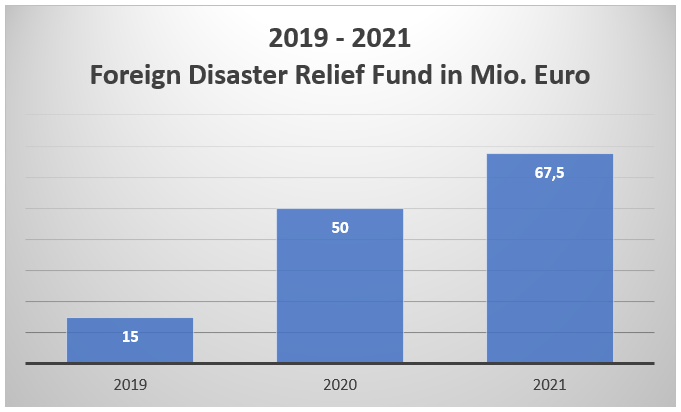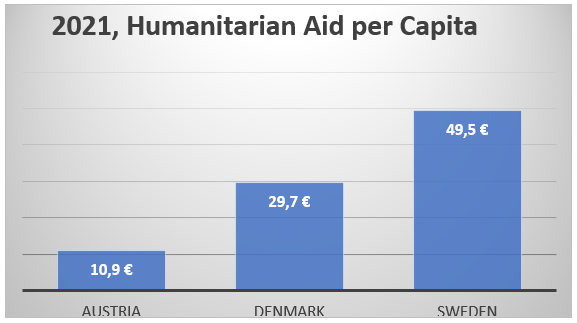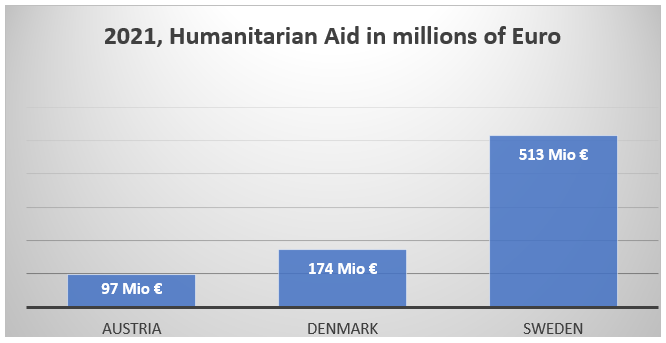Armed conflicts, climate crisis and environmental degradation, economic shocks and inflation, consequences of COVID-19, persistent poverty, global displacement – the challenges are many. And numbers of people affected reach new heights:
- 339 million people worldwide in need of humanitarian assistance (UN)
- 103 million displaced people in 2022 (UN)
- 349 Million facing acute food insecurity (WFP)
Over the next 15 years forced migration, disasters, conflicts, and inequality will likely rise further (UNICEF). The number of people affected by hunger might rise to one billion even much earlier (UN, WFP).
When multiple vulnerabilities cumulate, they end up as multi-pronged attacks on societal capacity and accelerate the descent of the most vulnerable humans into a downward spiral of daily fight for survival.
As a global society, it is a humanitarian imperative to look beyond the figures at the individual human face of need, to save all lives and to protect all persons affected when disaster strikes. It obliges us to leave no one behind, to not prioritize one crisis, to not fund only some people’s needs and some people’s rights. Yet, the gap between available financial resources and humanitarian requirements is widening. Humanitarian actors end up having to prioritize and to reduce suffering to the extent possible within the available resources.
It is the duty of governments world-wide to make sure that the world complies with the humanitarian imperative. We as humanitarian organizations need and therefore demand humanitarian systems, instruments and financing that are fit for purpose in a crisis-prone world.
Deep structural reforms and sustainable ways forward must be defined and implemented in order to reach a situation where crises can be addressed promptly and with sufficient, flexible, unrestrained and longer-termed resources. Only then will we collectively be able to fulfil the obligation to help all in need of humanitarian assistance and to eliminate the system of priorities in this plethora of emergencies. Necessary measures include:
- Policy coherence across national borders and across public and private donor systems.
- Reviewing and improving the financing architecture – money must arrive at the right time, at the right place, in the right way.
- Setting up sustainable mechanisms for dealing with protracted crises and ensuring the adequate resources.
- Improving the predictability of funding, for example through multi-annual systematic funding commitments.
- Respect the leadership, capacity and delivery of local humanitarian actors while strengthening them.
- Reducing bureaucracy and streamlining reporting requirements.
- Broad and robust humanitarian exemptions in sanctions regimes, counter-terrorism legislation (CTL) and alike.
Unfortunately, instead of stepping up to the challenge some national governments deprioritise humanitarian aid while most others do not lift its priority to match the actual and future humanitarian needs.
Austrian Humanitarian Aid Policy
The Austrian government recognized the need for reliable humanitarian financing and increased the funding of the Foreign Disaster Relief Fund (FDRF), the most relevant instrument of Austrian humanitarian aid, consistently in recent years.
The Austrian government raised the FDRF from 15 million Euros in 2019 to 50 million Euros in 2020, to 67.5 million Euros in 2021, due to the crisis in Afghanistan.

In 2022, a one-off action by the Austrian government raised the FDRF to 105 million Euros due to the international armed conflict in Ukraine.
As a further advance, in 2020 the government introduced the position of Special Representative for Humanitarian Aid to improve coordination between the various stakeholders in Austria.
Despite the progress made with the FDRF, Austria’s humanitarian aid is still far behind European countries such as Denmark and Sweden.
In 2021 Austria reached an expenditure of 10,90 Euros per capita on Humanitarian Aid, whereas the Danish government spent 29,70 Euros per capita on Humanitarian Aid and the Swedish government spent 49,50 Euros per capita on Humanitarian Aid.

In total, the Austrian government spent 97 million Euros on Humanitarian Aid in 2021. Denmark had a budget of 174 million Euros and Sweden budgeted 513 million Euros for Humanitarian Aid.

For the year 2022 updated figures on Humanitarian Aid per Capita and Humanitarian Aid in total are not available yet and are expected to be released in the near term. Although the humanitarian funding situation in Austria did improve, it is expected that the average per capita continues to trail behind that of other OECD countries.
To make Austria a force which shapes and improves the international humanitarian situation the Austrian humanitarian organisation recommend the following national measures:
- To continue increasing the humanitarian funding.
- To improve the predictability of humanitarian funding by committing funds beyond the annual budget (multi-annual financing).
- To fasten the release of emergency funding in case of sudden-onset disasters.
- To increase and formalise the regular dialogue between all government departments involved in humanitarian aid and to empower the Humanitarian Coordination Platform.
- To invest in and strengthen measures of disaster preparedness and anticipatory action.
- To promote and strengthen compliance with International Humanitarian Law and enable humanitarian organizations to fulfil their mandate accordingly.
- To foster and benefit from technological and social innovation and research for humanitarian purposes and strengthen the interaction with the scientific community in this respect.
Internationally we are at a major crossroad. It is both challenging for traditional actors and an opportunity for leaders to create a more inclusive and effective humanitarian system that takes full account both of those working in the humanitarian system and those the system serves. Austria has the potential and the chance to be one of the drivers for the necessary changes.


















